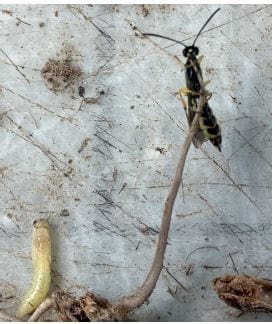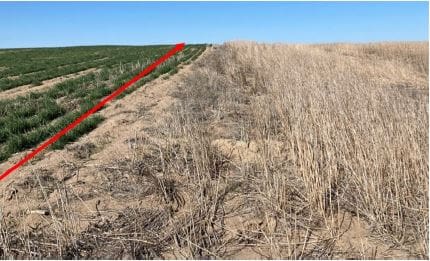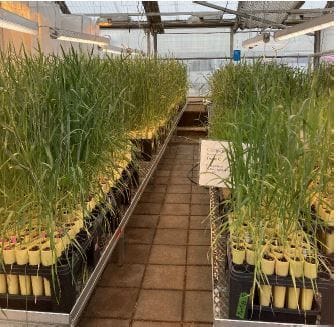Request For Crop Rotation Field Sites: CWRF-funded research project
As part of our CWRF-funded research, we are studying the impacts of crop rotations on sawfly infestations, and we need more field sites! If you are interested in participating, please contact Adam about your rotation history and our team will come to sample your fields.
Adam Osterholzer: adam.osterholzer@colostate.edu, 970-222-9568
Dr. Punya Nachappa: Punya.Nachappa@colostate.edu, 785-383-4873 Visit our website at: https://www.csuwheatentomology.com/
Wheat Stem Sawfly (WSS) Updates
Wheat stem sawflies have started to emerge, and we captured our first individual in New Raymer on 5-7-24 (Figure 1). Typically, males emerge first followed by females. Our wheat stem sawfly phenology model estimated 149 degree-day (DD) for sawfly emergence which was 5-4-24 in New Raymer but the cool weather we experienced last week may have delayed their emergence. Still, our model estimation is close because 5-7-24 was 161DD in New Raymer.
We predict that females will become more abundant by early next week. The recent warm weather has resulted in a significant increase in the rate of pupal development, meaning that most adults should be out soon.


Wheat Stem Sawfly Scouting
,Where to scout: Wheat fields will be particularly vulnerable along edges that border stubble from the previous year. Sawflies will emerge from the stubble and move towards the current crop. In the location shown in Figure 2, we would look for sawflies along the red arrow’s path, as this is where the highest concentration of the insects would be.
How to track the sawfly population on your property: We use a long-handled sweep net to capture adults. Our team will sweep 100 times at the same locations across several weeks (one 180-degree arc of the net = one sweep). Growers can use this same method to get an average of how many sawflies are present in their crops.
When to look for adults: Rainfall, high winds, and cold temperatures are all conditions that adult sawflies will deter sawflies from emerging. Growers should try to prioritize scouting during warm, calm mornings. Scouting during adverse weather can lead to the false impression that no sawflies are present!
How to recognize WSS eggs: Another method for gauging sawfly infestation is to split wheat stems down the full length of the stem. If sawfly eggs are present, they are easiest to see with a magnifying glass. Eggs will be small (roughly 1mm long), white, and oval-shaped (Figure 3).

Project Highlight: Wheat Genetics Research Center (Kansas State University) screening wild wheat species for novel sources of resistance
This on-going project is performed in collaboration with the Wheat Genetics Research Center (Kansas State University) and funding from CWAC. Wheat lines are grown in cone-tainers in our greenhouse and exposed to natural sawfly infestation in the field (Figure 4). Exposure to sawflies will begin next week in New Raymer. Sawflies cannot be reared in the lab; hence we have to bring the plants to the field to be infested. We monitor WSS egg-laying preferences and larval survival in 205 different wheat lines. The results from this project will be made available at future presentations and on our website!

Wheat Diseases
For wheat disease updates by Dr. Robyn Roberts, please see:
https://coloradowheat.org/category/news-events/wheat-pest-and-disease-update/
Acknowledgements
We would like to acknowledge the tireless work of CSU researchers and extension agents for reporting pest problems throughout the state. Special thanks to Kevin Larson, Brett Pettinger, Ron Meyer, Todd Ballard, Sally Jones-Diamond, Dennis Kaan, Kat Caswell, and Michaela Mattes.